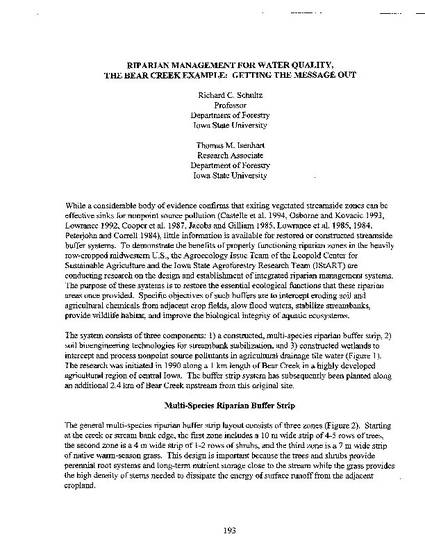
Presentation
Riparian Management for Water Quality, the Bear Creek Example: Getting the Message Out
Proceedings of the 7th Integrated Crop Management Conference, Ames, IA
Document Type
Conference Proceeding
Disciplines
Publication Version
Published Version
Publication Date
1-1-1995
Abstract
While a considerable body of evidence confirms that exiting vegetated streamside zones can be effective sinks for nonpoint source pollution (Castelle et al. 1994, Osborne and Kovacic 1993, Lowrance 1992, Cooper et al. 1987, Jacobs and Gilliam 1985, Lowrance et al. 1985, 1984, Peterjohn and Correll 1984 ), little information is available for restored or constructed streamside buffer systems. To demonstrate the benefits of properly functioning riparian zones in the heavily row-cropped midwestern U.S., the Agroecology Issue Team of the Leopold Center for Sustainable Agriculture and the Iowa State Agroforestry Research Team (!StART) are conducting research on the design and establishment of integrated riparian management systems. The purpose of these systems is to restore the essential ecological functions that these riparian areas once provided. Specific objectives of such buffers are to intercept eroding soil and agricultural chemicals from adjacent crop fields, slow flood waters, stabilize streambanks, provide wildlife habitat, and improve the biological integrity of aquatic ecosystems.
Copyright Owner
Iowa State University
Copyright Date
1995
Language
en
File Format
application/pdf
Citation Information
Richard C. Schultz and Thomas M. Isenhart. "Riparian Management for Water Quality, the Bear Creek Example: Getting the Message Out" Proceedings of the 7th Integrated Crop Management Conference, Ames, IA (1995) p. 193 - 199 Available at: http://works.bepress.com/thomas_isenhart/41/

This proceeding is from the 7th Integrated Crop Management Conference (1995): 193. Posted with permission.